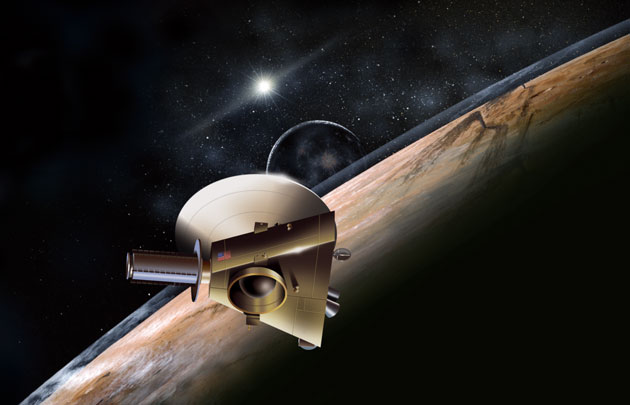 |
|||||
| New Horizons over Mysterious Pluto | |||||
| Faraway | History | Planet | Moons | Spacecraft | Go Now |
Pluto is a Faraway Enigma
LATEST NEWS ON NEW HORIZONS » IT'S A WARM WINTER ON PLUTO »
Pluto is one of the most mysterious objects in our Solar System because it's the farthest planet and we know very little about it. Pluto's average distance from the Sun is 3.67 billion miles. That's 39.5 times the average distance between the Sun and Earth.
Pluto has a strange orbit. It is the only one to cross another planet's orbit. The small planet travels an unusual path around the Sun, which sometimes brings it closer to the Sun than the planet Neptune. Scientists say it has an eccentric orbit because it resembles a circle that's been squashed. A year for Pluto — one revolution around the Sun — is equivalent to 248 Earth years.
From 1979 to 1999, Pluto was the eighth planet from the Sun. In 1999, it crossed Neptune's path to again become the Solar System's most distant planet. It will remain in that ninth planet position for 228 years before crossing inside Neptune's orbit again.
Pluto and Netpune will never collide because their orbits are very different. Pluto can be visualized as above Neptune in the orbital plane. The two planets always are separated by more than a billion miles.
Moving away. Pluto reached its closest point to the Sun in 1989 and is now moving farther away, which eventually will lead its thin atmosphere to freeze and fall to the planet's surface. Once frozen, that surface probably won't thaw until around 2230 as it swings back closer to the Sun. For that reason, proponents want to send a robot probe to Pluto now.
Pluto's great distance from Earth has kept the planet shrouded in mystery since its discovery. It is the only major planet in our Solar System not yet viewed close-up by a spacecraft. Given the planet's great distance and tiny size, studying it continues to challenge and extend the skills of planetary astronomers.
Most of the little we know about Pluto has been learned since the late 1970s. Many of the key questions about Pluto and its natural satellite Charon await the close-up observation of an unmanned robot-probe spaceflight mission. Pluto is the only one of the nine major planets that has not been visited by a probe from Earth.
Pluto At a Glance
Discovered: 1930
Diameter: 1,430 mi.
Orbit: 3.7 billion mi.
Day: 6 Earth days 9 hours
Year: 248 Earth years
Satellite: Charon
Referred to as "New Horizons: Shedding Light on Frontier Worlds," NASA's planned spacecraft to vists Pluto would be launched by 2004 to fly past Pluto around 2014. The probe would carry cameras and instruments to study the planet's geology and see how its atmosphere and surface interact.
A window is closing. Time is running out for those astronomers who are alive today to study the planet. Pluto's orbit makes the trip for a robot explorer lengthier and more expensive. If the project were to be postponed much longer, today's scientists wouldn't get another chance in their lifetimes; nor would their grandchildren for more than 200 years.
Astronomers already are seeing the planet appear duller. As Pluto recedes from us, it grows colder and much of its thin atmosphere of nitrogen, carbon monoxide, and methane flutters to the surface as frost and snowflakes.
Even as the snow covers up important aspects of Pluto's surface, planetary scientists will lose their chance to study the atmosphere. They calculate the freezing process could take from a few years to a few decades. Afterward, the planet will stay locked in a deep freeze until the 23rd century, when its orbit will bring it back toward the Sun.
The scientists also are running out of daylight. Pluto is at its equinox now and the Sun hits almost all parts of the planet as it rotates during a 153-hour-long Plutonian day. But Pluto is moving toward solstice where one hemisphere will be in shadow for decades. Every year the Pluto mission is delayed, 200,000 square kilometers will be lost to view. For instance, if the exploration project were delayed to arrive in 2030, it would be able to see only half as much of Pluto.
A one-way trip from Earth to Pluto would take 10 to 12 years.
Learn more about Pluto...About Pluto, Charon, the new moons and the Kuiper Belt
- Facts about Pluto SEDS Nine Planets
- New Moons Around Pluto Images and information
- Facts about the Kuiper Belt and the Oort Cloud
- Exploring Pluto Smithsonian Institution National Air and Space Museum
- The Struggles to Find the Ninth Planet by Clyde W. Tombaugh
- Many Pluto Web Pages
About New Horizons spacecraft and former Pluto-Kuiper Express
- New Horizons JHU APL
- The Pluto-Kuiper Express NASA JPL
- The Planetary Society
About the IAU Pluto Status Change Proposal
- Much Ado About Pluto NASA story
- The status of Pluto IAU Press Release 1999
- What is a planet? IAU discussion of Pluto's status
About the mystery object Quaoar beyond Pluto
- Quaoar FAQ CalTech
- The Kuiper Belt and the Oort Cloud SEDS
- Artist illustrations of Quaoar STScI
- Comparison of Quaoar with the Moon NASA artist
- Comparison of Quaoar with North America NASA artist
About Astrophysics and Pluto
- Science @ NASA NASA research on the web
- NASA Space Science News NASA Office of Space Science press releases
| Pluto: | Faraway | History | Planet | Moons | Spacecraft | Go Now | Internet Resources |
| Solar System | Search STO | STO Cover | Copyright 2006 Space Today Online | ||||